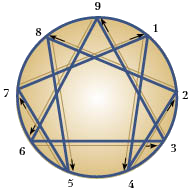
Personality type is ultimately determined by the person him/herself. It is difficult and often inaccurate to type another person because you must know their core motivation. We tend to type others based on what we see, but there are many reasons that a person may appear to behave a certain way. Only that person knows the real motivation. Public figures can often be typed by us because they have given interview after interview and have often been very generous with their deepest thoughts and feelings.
There are several "typing" tests available. Currently, the statistically most valid is the nine paragraph test in The Essential Enneagram (originally The Stanford Enneagram Discovery Inventory and Guide) by David Daniels, M.D. and Virginia Price, PhD. We have a link to the online test on our links page. Read the nine paragraphs and choose the ones that apply most accurately to you. Often, there is more than one type that feels right in the beginning. These different choices usually have a connection to one another as wings, connecting points or look-alike types. One of these is your core type.
We offer "typing interviews" which consist of questions designed by us to help you determine which types might fit your habits of thought, feeling and behavior. The interview lasts about 1.5 hours. Then we encourage you to do more reading until you feel that you have identified your perspective. The process takes a lot of thought, introspection and honesty. It can also help to talk to people who know you well.
Type identification includes how you have always been, even though you are certain that you are different now. We see ourselves mature and change, and it is almost certainly a maturation within our type structure. So we can be guided by our past, even when we disown it to some degree.
Sometimes, when we discover our type, we don't particularly like it. The descriptions may feel a little negative. Then we see the name of a famous person whom we cannot stand, and they are the same type. Sometimes, we think (hope) we are a type whose traits we admire and we resist seeing ourselves as we are. Remember that these profiles exist on a continuum. The low side of each type is not very flattering. The high side of each is very appealing. No single type is better than another. They are simply different.
cautions
Even though we are talking about personality "types", we are not talking about labeling people and creating stereotypes. We are not putting people in boxes. To the contrary, we are talking about describing the box we are in already, and finding a way to make it less constricting.
It is very easy to slip into labeling and justifying based on the Enneagram ("Of course I'm furious with you, I'm an EIGHT!) It is important to move quickly into understanding the growth edge or path of your type. Recognizing a cluster of characteristics that fit neatly into a type structure is not permission to justify behavior. But it can provide understanding and compassion for how the structure has operated up until now.